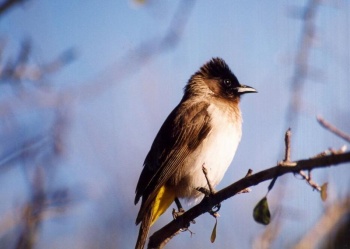Alternative names: Garden Bulbul; Somali Bulbul; Dodson's Bulbul; Dark-capped Bulbul
- Pycnonotus barbatus
Identification
The only Pycnonotus bulbul in most of its range and therefore generally easily identified.
15–20 cm (6-7¾ in)
- Distinctive head shape, due to slightly peaked crown
- Dark brown head and upperparts
- Grey brown below
- White or yellow vent according to subspecies
Sexes are alike, though female usually smaller. Juvenile similar, with duller grey-brown face, slightly paler upperparts, entirely white vent.
Distribution
Europe, Africa and Arabia
Europe: Canary Islands, Extremadura
Africa:
North Africa: Morocco, Algeria, Egypt
Western Africa: Mauritania, Senegal, The Gambia, Guinea-Bissau, Mali, Sierra Leone, Liberia, Ivory Coast, Burkina Faso, Ghana, Togo, Benin, Nigeria, Niger, Chad, Cameroon, Central African Republic, Equatorial Guinea, Gabon, Congo, Democratic Republic of Congo, Angola
Eastern Africa: Sudan, South Sudan, Eritrea, Ethiopia, Somalia, Kenya, Uganda, Rwanda, Burundi, Tanzania
Middle East: Syria, Arabian Peninsula, Oman

Photo © by Sal
Kruger National Park, South Africa,
Taxonomy
Sibley and Monroe propose to split this species into 4 species:
- Garden Bulbul Pycnonotus barbatus from Northern Africa south to Congo-Brazzaville and Ethiopia, with the exception of the Sahara and other arid regions where generally absent.
- Dodson's Bulbul Pycnonotus dodsoni
- Dark-capped Bulbul Pycnonotus tricolor
- Somali Bulbul Pycnonotus somaliensis
However, neither Howard and Moore nor Clements accept this split, neither does the Handbook of the Birds of the World.
This split is mainly based on morphology, especially in colour of vent (whitish or yellow), presence/absence of a white patch on the auriculars, and exact chest pattern. They interbreed widely at most localities where they meet.
Subspecies
Clements accepts 10 subspecies[1]:
- P. b. barbatus: Morocco, Algeria and Tunisia
- P. b. inornatus: Senegal to Ghana, northern Niger, northern Nigeria, northern Cameroon and western Chad
- P. b. gabonensis: Central Nigeria and central Cameroon to Gabon and southern Congo
- P. b. arsinoe: Egypt (Nile Valley), eastern Chad, Sudan, and northern South Sudan
- P. b. schoanus: White undertail coverts and dark hindneck
- Eritrea, Ethiopia, and southeastern South Sudan
- P. b. somaliensis: White undertail coverts and whitish hindneck
- P. b. spurius: Yellow undertail coverts and dark hindneck
- Southern Ethiopia (southern Bale to northern Sidamo-Borama)
- P. b. dodsoni:Yellow undertail coverts and whitish hindneck
- P. b. tricolor: Eastern Cameroon east to South Sudan and central Kenya, south to northern Namibia, Democratic Republic of the Congo, northwestern Botswana, and northern and western Zambia
- P. b. layardi: South-eastern Kenya to eastern Tanzania, Zambia, north-eastern Botswana and South Africa

Photo © by volker sthamer
Click on image to enlarge
Habitat
Virtually any habitat with some fruiting trees, but they generally avoid dense forest. They are common where the forest has been fragmented by human settlement and is in the first stages of regeneration.
Behaviour
An adaptable and very bold bird which readily adapts to life alongside humans.
Breeding
Breeding times vary with location, but are generally March to September in North African locations, e.g. March-August in Egypt. In the central and southern countries of Africa, the range is July to April, e.g. August-March in Botswana.
The birds are monogamous, solitary nesters. The cup nest (7.5-12 cm in diameter and 5-6 cm deep) is built by the female, from small twigs, rootlets and dry grass and lined with animal hair and plant fibres. It is built on twigs or a branch 1-5 m above the ground, often close to human activity, but screened by vegetation.
2-5 eggs are laid, 1 a day, and incubation begins on completion of the clutch. Male feeds female on the nest during incubation, which is 12-15 days. The young are fed by both parents, fledging in 13-16 days. They can barely fly so they keep together on a branch where the parents continue to feed them, until they can fend for themselves.
Brood parasitism by Jacobin Cuckoo is frequent, with occasional activity from 3 or 4 other species of cuckoo.
Diet
The diet consists mostly of a variety of fruit. They also eat insects, arthropods, small vertebrates such as geckoes, nectar, flowers and some seeds.
Vocalisation
Song: loud doctor-quick doctor-quick be-quick be-quick. Alarm call: loud kik-kik-kik (like the noise of a machine-gun)
References
- Clements, J. F., T. S. Schulenberg, M. J. Iliff, D. Roberson, T. A. Fredericks, B. L. Sullivan, and C. L. Wood. 2017. The eBird/Clements checklist of birds of the world: v2017, with updates to August 2017. Downloaded from http://www.birds.cornell.edu/clementschecklist/download/
- Fishpool, L. and J. Tobias (2020). Common Bulbul (Pycnonotus barbatus), version 1.0. In Birds of the World (J. del Hoyo, A. Elliott, J. Sargatal, D. A. Christie, and E. de Juana, Editors). Cornell Lab of Ornithology, Ithaca, NY, USA. https://doi.org/10.2173/bow.combul2.01
- Wikipedia
Recommended Citation
- BirdForum Opus contributors. (2024) Common Bulbul. In: BirdForum, the forum for wild birds and birding. Retrieved 16 April 2024 from https://www.birdforum.net/opus/Common_Bulbul
External Links
Search the Gallery using the scientific name:
Search the Gallery using the common name:
GSearch checked for 2020 platform.






